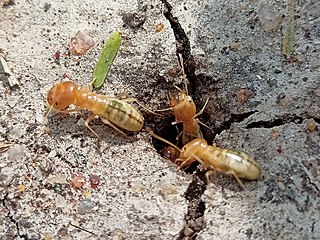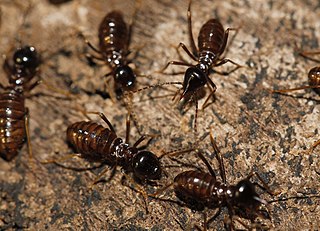
Anacanthotermes viarum is a species of harvester termite in the family Hodotermitidae. It is found in India and Sri Lanka. It is a grass feeder.
Glyptotermes ceylonicus, is a species of damp wood termite of the genus Glyptotermes. It is endemic to high elevations Sri Lanka. It is a pest of dead and decaying wood of Hevea, Theobroma, Ficus, and Acacia species.
Bifiditermes pintoi is a species of damp wood termite of the genus Bifiditermes. It is found in Sri Lanka.
Cryptotermes bengalensis, is a species of dry wood termite of the genus Cryptotermes. It is native to India, Bangladesh, Thailand and introduced to Sri Lanka. It is found in dead and rotten wood of Ficus species. It is a pest of Diospyros insignis.
Coptotermes emersoni, is a species of subterranean termite of the genus Coptotermes. It is native to India, Sri Lanka, and Vietnam. Though it is a wood destroying termite, it was first found from an electrical wire case in the National Museum of Colombo.
Coptotermes gaurii, is a species of subterranean termite of the genus Coptotermes. It is native to South India and Sri Lanka. It is a serious pest of tea in Sri Lanka.
Heterotermes indicola, is a species of subterranean termite of the genus Heterotermes. It is native to tropical India, Pakistan and Sri Lanka but has extended its range into the subtropics and warm temperate areas of the Himalayan foothills to altitudes of about 2,000 m (6,600 ft). It causes damage to timber in buildings and is one of the most destructive termites in urban and agricultural areas in the world. Soldiers are about 4.1-4.9mm long. Extracts of garlic and Calotropis procera are known to have termiticidal effects on H. indicola.
Macrotermes convulsionarius is a species of termite of the family Termitidae. It is native to India and Sri Lanka. Soldiers are very large with well developed mandibles. It is a major pest of many wood works in buildings. Flagellated bacteria such as Bacillus, Acinitobacter, Salmonella, Enterobacter, and Enterococcus are found abundant in gut of M. convulsionarius.
The sugarcane termite is a species of termite of the genus Odontotermes. It is native to India and Sri Lanka. It is recorded from coconut palms and is a pest of sugarcane.
The Fungus-growing termite,, also known as South Asian wood-destroying termite, is a small species of earth dwelling termite of the genus Odontotermes. It is native to India and Sri Lanka.
Odontotermes globicola is a species of small termite of the genus Odontotermes. It is native to India, Malaysia and Sri Lanka. It is found under flower pots and decaying logs. They construct small chambered nest with spherical combed termitaria.

Odontotermes horni, is a species of termite of the genus Odontotermes. It is native to India and Sri Lanka. It attacks many dead, decaying trees and fertilized soil. Though nests on ground, they do not construct a termitaria. It is a pest of tea, coconut and sugarcane.
Hypotermes obscuriceps, is a species of termite of the genus Hypotermes. It is native to India, Sri Lanka and Vietnam. It constructs a termitaria and is a pest of tea.
Nasutitermes lacustris, is a species of termite of the genus Nasutitermes. It is found in India and Sri Lanka. This species builds nests on branches of forest trees and can be found in stems of trees like Anacardium, Hevea and Elaeocarpus.
Nasutitermes oculatus, is a species of termite of the genus Nasutitermes. It is found in India and Sri Lanka. It lives within the stems of Dendrocalamus giganteus.

Hospitalitermes monoceros, is a species of nasute termite of the genus Hospitalitermes. It was originally considered to be endemic to Sri Lanka, but was also found in India in 2013. It is an obligate lichen feeder. It is recorded from Cassia multijuga and Ficus religiosa trees and is a pest of tea.
Trinervitermes biformis, the snouted harvester termite, is a species of mound building termite in the genus Trinervitermes, native to India and Sri Lanka. The type species was described from the Bandarawela area of Sri Lanka. It is a pest of sugarcane and brinjal.
Dicuspiditermes nemorosus, is a species of small termite of the genus Dicuspiditermes. It is found in Sri Lanka, India, Malaysia and Borneo. The species is known to build three different types of mounding nests, where two termitaria have single protruding nest structure and third nest type is typified by several protruding nest all connected at the base.
Glyptotermes is a genus of termite in the family Kalotermitidae. With 127 species worldwide as of 2013, is the family's most speciose genus, and the second most speciose in the New World after Cryptotermes.


